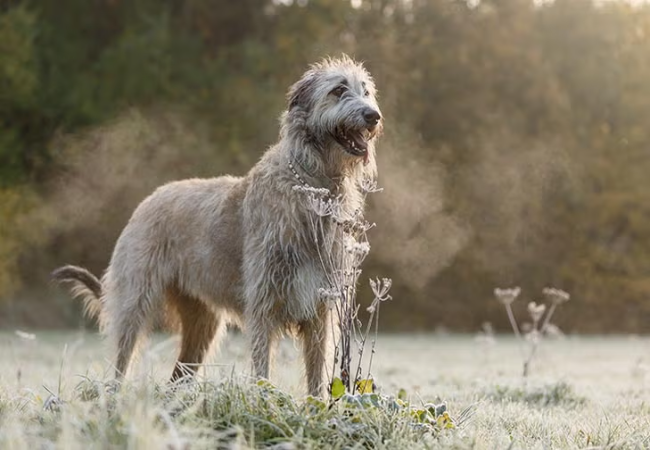Irish Wolfhound 2025 Guide: Temperament, Care & Training 🐶

In this article
Irish Wolfhound 2025 Guide: Temperament, Care & Training 🐶
By Dr. Duncan Houston BVSc
The Irish Wolfhound is the tallest dog breed in the world—an ancient warrior turned gentle giant. With their calm demeanor and commanding presence, these dogs are as affectionate as they are impressive. In this expert 2025 guide, you’ll learn how to care for, train, and understand the needs of the noble Irish Wolfhound. 🐾
📜 Breed Origins
This breed dates back to antiquity, originally bred in Ireland to hunt wolves and big game. They were valued by royalty for their size, speed, and courage. Though their hunting role has faded, their place as loving companions has only grown. 🇮🇪
🧠 Temperament & Personality
Despite their size, Irish Wolfhounds are sweet, quiet, and reserved:
- Gentle: Affectionate and sensitive with their family
- Dignified: Calm and composed—not typically silly or loud
- Loyal: Forms strong but subtle attachments
- Quiet: Rarely barks unless necessary
🏡 Ideal Home Environment
This breed thrives with space, stability, and softness:
- Homes with large living areas and secure outdoor space
- Experienced owners who understand giant breeds
- Cooler climates—they overheat easily
Not ideal for small apartments or homes with slippery floors or stairs. 🏡
✂️ Coat Type & Grooming
The Wolfhound’s wiry coat is weather-resistant and relatively low maintenance:
- Brushing: 1–2 times weekly to remove loose hair
- Bathing: Every 6–8 weeks or as needed
- Hand-stripping: Occasionally to maintain texture
- Ear/Nail Care: Clean ears weekly; trim nails monthly
🏃♂️ Exercise & Enrichment
This is a moderately active breed that enjoys relaxed exercise:
- Daily walks (30–60 minutes)
- Short bursts of off-leash play in secure areas
- Gentle games and enrichment like puzzle feeders
Avoid high-impact activity—giants are prone to joint issues. 🧠
🍗 Nutrition & Feeding
Feed a large-breed formula tailored to growth and joint support:
- Animal-based proteins (chicken, beef, lamb)
- Joint supplements (glucosamine, chondroitin)
- Moderate calcium and phosphorus for skeletal health
Feed multiple small meals to prevent bloat. For guidance, use Ask A Vet. 🍽️
🩺 Common Health Concerns
This breed has a shorter lifespan (6–10 years) and may face:
- Dilated Cardiomyopathy (DCM): A heart condition common in large breeds
- Bloat (GDV): A life-threatening emergency—manage meals and exercise
- Osteosarcoma: Bone cancer risk increases with age
Preventive care and early screening are vital. Use Ask A Vet for monitoring. 🩺
🎓 Training & Socialization
This breed is calm and trainable with consistency:
- Start socialization and leash training early
- Use calm praise and food-based rewards
- Monitor play with smaller pets—size may intimidate
🧘♂️ Emotional Needs
Wolfhounds are emotionally sensitive and prefer quiet companionship:
- Provide soft resting spaces and calm environments
- They prefer being near family but don’t demand constant attention
- Offer predictable schedules and gentle care
Consult Ask A Vet for emotional and behavioral support. 🧠
🏁 Final Thoughts: Is the Irish Wolfhound Right for You?
If you're seeking a majestic, loving, and calm companion who brings presence and peace to your home, the Irish Wolfhound may be your perfect match. With the right space, care, and love, these gentle giants are unforgettable companions. ❤️
Need help creating a care plan? Start a consult now at Ask A Vet!






